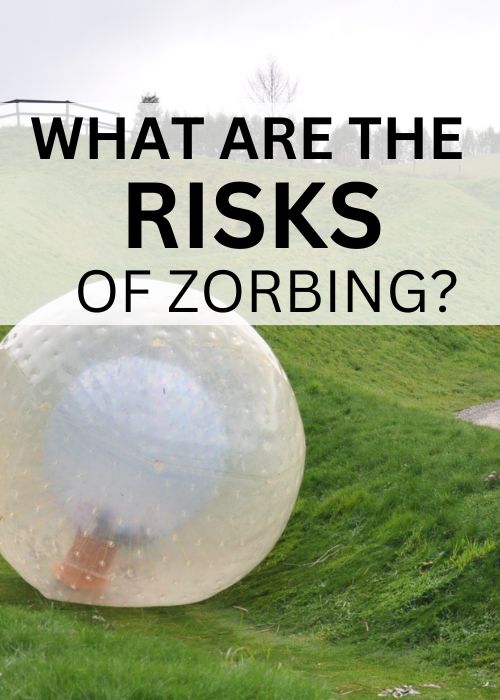
Zorbing, the exhilarating sport where participants roll down a hill or along a flat surface inside a large, transparent plastic ball, has captured the imagination of thrill-seekers worldwide.
While zorbing can be a fun and unique experience, like any adventure sport, it comes with its own set of risks.
Understanding these risks is essential for ensuring a safe and enjoyable experience. In this blog post, we’ll explore the potential hazards associated with zorbing and provide tips on how to minimize them.
1. Injuries from Collisions and Impact
One of the most significant risks of zorbing is injury from collisions and impacts.
As the zorb rolls down a hill or across a surface, participants can be thrown around inside the ball, especially if they are not secured.
Colliding with the ground or other objects can lead to bruises, cuts, and more severe injuries such as fractures or concussions.
How to Minimize the Risk:
- Always ensure the zorb is used in a controlled environment, free from obstacles such as rocks, trees, or uneven surfaces.
- Use a harnessed zorb to secure yourself inside the ball and reduce excessive movement.
- Follow the instructions and guidelines provided by the zorbing facility or operator.
2. Suffocation and Heat-Related Issues
Zorbing takes place inside a sealed plastic ball, which can lead to a buildup of heat and humidity.
In extreme cases, this can cause dehydration, overheating, or even suffocation, especially if participants are inside the zorb for extended periods.
How to Minimize the Risk:
- Limit the duration of each zorbing session to a few minutes to avoid overheating.
- Ensure the zorb has adequate ventilation. Some zorbs have small air holes to allow for airflow.
- Stay hydrated and take breaks between sessions to cool down.
3. Water Zorbing Risks
Water zorbing, where the zorb is used on a body of water, introduces unique risks.
Participants can potentially drown if they become disoriented inside the ball, especially if they do not know how to swim.
Additionally, water-zorbing balls may leak or deflate, leading to an increased risk of water entering the ball.
How to Minimize the Risk:
- Only attempt water zorbing if you are a competent swimmer.
- Make sure the zorb is in good condition with no visible leaks or damage.
- Have a lifeguard or experienced supervisor present during water zorbing activities.
4. Inadequate Equipment and Supervision
Using poor-quality equipment or lack of proper supervision can significantly increase the risk of accidents and injuries.
Faulty zorbs that are not regularly inspected can lead to tears, punctures, or deflation, creating hazardous situations for participants.
How to Minimize the Risk:
- Choose reputable zorbing operators who maintain their equipment to high safety standards.
- Ensure that the zorbing activity is supervised by trained professionals who can provide guidance and assistance.
- Inspect the zorb before use for any signs of wear, damage, or defects.
5. Environmental Hazards
The environment where zorbing takes place plays a crucial role in safety.
Uneven terrain, steep slopes, and unpredictable weather conditions can all contribute to accidents and injuries.
Wind can also pose a danger by causing the zorb to move unpredictably.
How to Minimize the Risk:
- Opt for zorbing in controlled environments designed specifically for the activity.
- Avoid zorbing on steep or rocky slopes and in adverse weather conditions.
- Check the weather forecast and choose a day with calm, predictable weather for your zorbing adventure.
6. Participant Health Conditions
Zorbing can be a physically demanding activity that may not be suitable for everyone.
Individuals with certain health conditions, such as heart problems, epilepsy, or severe claustrophobia, may be at greater risk of injury or distress while zorbing.
How to Minimize the Risk:
- Consult with a healthcare professional before participating in zorbing if you have any underlying health conditions.
- Inform the zorbing operator of any medical conditions or concerns you may have.
- Consider alternative activities if zorbing is not suitable for your health condition.
Conclusion
While zorbing offers a thrilling and unique experience, it’s important to be aware of the potential risks involved.
By taking proper precautions, such as using quality equipment, ensuring adequate supervision, and being mindful of environmental conditions, you can minimize these risks and enjoy a safe zorbing adventure.
Always prioritize safety and make informed decisions to ensure your zorbing experience is as fun and memorable as it is safe.
More Zorbing:
Walk on Water? Do the Water Zorb
Zorbing Adventure? Thrills on Water, Grass, and Snow
Zorbing Risks.